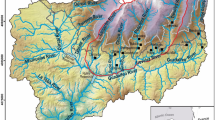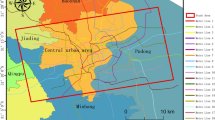Abstract
The western part of Guizhou is located in the second step of East Asia. Although the area is stratigraphically continuous and the surface is dominated by hard limestone and sandstone, catastrophic landslides often occur, seriously threatening residents' lives and the safety of property. Accurate identification of landslides and analysis of their developmental patterns are vital to prevent and reduce the threat of geological disasters. No active landslide survey data cover this region, so this paper identifies the active landslides in the western part of Guizhou by combining surface deformation information, multitemporal optical remote sensing images, geological lithology, and geomorphic features to obtain deformation information from multisource synthetic aperture radar surface data. This process increases the accuracy and reliability of identifying unstable slopes in areas with dense vegetation and steep terrain. By processing 283 Sentinel-1 and PALSAR-2 synthetic aperture radar data, 578 active landslides, 18 of which are high-risk large-scale landslides (landslide groups), are delineated for the first time in a range of 4.64 × 104 km2 in the study area. The active landslides mainly include natural landslides, reservoir landslides, and mining-induced landslides, accounting for 2.4%, 4.2 %, and 93.4%, respectively. The spatial distribution of landslides is banded along the cuesta at the edge of an outcrop of coal strata. Landslides are mainly distributed at elevations of 1800–2000 m, with an elevation difference of 50 ~ 100 m and a slope range of 35° ~ 40°. The landslides are characterized by steep slopes, small scales, mass occurrences, and no dominant slope direction, classifying them as cuesta landslides induced by mining disturbance. Furthermore, nuanced remote sensing interpretation of the disaster elements, such as cuesta cliff, tensile cracks, deep and sizeable tensile channels, isolated rock masses, and collapse debris, and their processes of change, reveals that coal mining-disturbed landslides in this region have experienced four primary stages: natural unloading, mining disturbance, displacement acceleration, and slope failure. This is of great significance for understanding the genetic mechanism and developmental patterns, as well as the risk assessment, of this region.


(modified by the 1:200 000 geological map provided by China Geological Survey)









Similar content being viewed by others
References
Ali JR, Thompson GM, Zhou M-F, Song X (2005) Emeishan large igneous province, SW China. Lithos 79:475–489
Carlà T, Farina P, Intrieri E et al (2018) Integration of ground-based radar and satellite InSAR data for the analysis of an unexpected slope failure in an open-pit mine. Eng Geol 235:39–52
Cascini L, Fornaro G, Peduto D (2010) Advanced low- and full-resolution DInSAR map generation for slow-moving landslide analysis at different scales. Eng Geol 112:29–42
Chen L, Zhao C, Kang Y et al (2020) Pre-event deformation and failure mechanism analysis of the Pusa landslide, China with multi-sensor SAR imagery. Remote Sens 12:856
Chen L, Zhao C, Li B et al (2021) Deformation monitoring and failure mode research of mining-induced Jianshanying landslide in karst mountain area, China with ALOS/PALSAR-2 images. Landslides 18:2739–2750
Dai F, Deng J (2020) Development characteristics of landslide hazards in three-rivers basin of southeast Tibetan Plateau. Adv Eng Sci 52(5):3–15 ((in Chinese))
Fan X, Xu Q, Alonso-Rodriguez A et al (2019) Successive landsliding and damming of the Jinsha River in eastern Tibet, China: prime investigation, early warning, and emergency response. Landslides 16:1003–1020
Fan X, Xu Q, Scaringi G et al (2019) The “long” runout rock avalanche in Pusa, China, on August 28, 2017: a preliminary report. Landslides 16:139–154
Gao Y, Li B, Gao H et al (2020) Dynamic characteristics of high-elevation and long-runout landslides in the Emeishan basalt area: a case study of the Shuicheng “7.23”landslide in Guizhou China. Landslides 17:1663–1677
Hu J, Li ZW, Ding XL et al (2014) Resolving three-dimensional surface displacements from InSAR measurements: a review. Earth-Sci Rev 133:1–17
Huang RQ (2007) Large-scale landslides and their sliding mechanisms in china since the 20th century. Chin J Rock Mech Eng 26(3):433–454 ((in Chinese))
Huang Q, Cai Y (2007) Spatial pattern of Karst rock desertification in the Middle of Guizhou Province, Southwestern China. Environ Geol 52:1325–1330
Kang Y, Zhao C, Zhang Q et al (2017) Application of InSAR techniques to an analysis of the guanling landslide. Remote Sens 9:1046
Li ZW, Yang ZF, Zhu JJ et al (2015) Retrieving three-dimensional displacement fields of mining areas from a single InSAR pair. J Geod 89:17–32
Li L, Yao X, Yao J et al (2019) Analysis of deformation characteristics for a reservoir landslide before and after impoundment by multiple D-InSAR observations at Jinshajiang River China. Nat Hazards 98:719–733
Li W, Xu Q, Lu H et al (2019b) Tracking the deformation history of large-scale rocky landslide and its enlightenment. Geomat and Inform Sci Wuhan Univ 44:1043–1053 ((in Chinese))
Li B, Yin Y, Gao Y et al (2020) Critical issues in rock avalanches in the karst mountain areas of southwest China. Hydrogeol Eng Geol 47:5–13 ((in Chinese))
Liu X, Zhao C, Zhang Q et al (2021) Integration of Sentinel-1 and ALOS/PALSAR-2 SAR datasets for mapping active landslides along the Jinsha River corridor, China. Eng Geol 284:106033
Mondini AC, Guzzetti F, Chang K-T et al (2021) Landslide failures detection and mapping using synthetic aperture radar: past, present and future. Earth-Sci Rev 216:103574
Qu F, Qiu H, Sun H, Tang M (2021) Post-failure landslide change detection and analysis using optical satellite Sentinel-2 images. Landslides 18:447–455
Samsonov S, d’Oreye N, Smets B (2013) Ground deformation associated with post-mining activity at the French-German border revealed by novel InSAR time series method. Int J Appl Earth Obs Geoinform 23:142–154
Shi X, Zhang L, Zhong Y et al (2020) Detection and characterization of active slope deformations with sentinel-1 InSAR analyses in the southwest area of Shanxi China. Remote Sens 12:392
Strozzi T, Wegmuller U, Werner C, Wiesmann A (2000) Measurement of slow uniform surface displacement with mm/year accuracy. In: Proceedings of GARSS, July 24-28, Honolulu, HI. https://doi.org/10.1109/IGARSS.2000.858368
Wang J, Wang C, Xie C et al (2020) Monitoring of large-scale landslides in Zongling, Guizhou, China, with improved distributed scatterer interferometric SAR time series methods. Landslides 17:1777–1795
Wang Y, Liu D, Dong J et al (2021) On the applicability of satellite SAR interferometry to landslide hazards detection in hilly areas: a case study of Shuicheng Guizhou in Southwest China. Landslides. https://doi.org/10.1007/s10346-021-01648-y
Werner C, Wegmuller U, Strozzi T, et al (2003) Interferometric point target analysis for deformation mapping. In: Proceedings of IGARSS, 21-25 July, Toulouse, France. https://doi.org/10.1109/IGARSS.2003.1295516
Xing A, Wang G, Li B et al (2015) Long-runout mechanism and landsliding behaviour of large catastrophic landslide triggered by heavy rainfall in Guanling, Guizhou, China. Can Geotech J 52:971–981
Xu C, Xu X, Yao X, Dai F (2014) Three (nearly) complete inventories of landslides triggered by the May 12, 2008 Wenchuan Mw 7.9 earthquake of China and their spatial distribution statistical analysis. Landslides 11:441–461
Yao X, Li L, Zhang Y et al (2017) Types and characteristics of slow-moving slope geo-hazards recognized by TS-InSAR along Xianshuihe active fault in the eastern Tibet Plateau. Nat Hazards 88:1727–1740
Yao X, Deng J, Liu X et al (2020) Primary recognition of active landslides and development rule analysis for pan three-river-parallel territory of Tibet Plateau. Adv Eng Sci 52(5):16–37 ((in Chinese))
Yin Y, Sun P, Zhang M, Li B (2011) Mechanism on apparent dip sliding of oblique inclined bedding rockslide at Jiweishan, Chongqing, China. Landslides 8:49–65
Zhao W, Wang R, Liu X et al (2020) Field survey of a catastrophic high-speed long-runout landslide in Jichang Town, Shuicheng County, Guizhou, China, on July 23, 2019. Landslides 17:1415–1427
Zheng D, Frost JD, Huang RQ, Liu FZ (2015) Failure process and modes of rockfall induced by underground mining: a case study of Kaiyang Phosphorite Mine rockfalls. Eng Geol 197:145–157
Zhu Y, Xu S, Zhuang Y et al (2019) Characteristics and runout behaviour of the disastrous 28 August 2017 rock avalanche in Nayong, Guizhou, China. Eng Geol 259:105154
Acknowledgements
This research was funded by the National Key R&D Program of China (2018YFC1505002), National Science Foundation of China (41672359) and China Three Gorges Corporation (YMJ (XLD) (19) 110). We thank the anonymous reviewers for their constructive comments and patient grammar improvements.
Author information
Authors and Affiliations
Corresponding author
Additional information
Publisher's Note
Springer Nature remains neutral with regard to jurisdictional claims in published maps and institutional affiliations.
Rights and permissions
About this article
Cite this article
Zhu, Y., Yao, X., Yao, L. et al. Detection and characterization of active landslides with multisource SAR data and remote sensing in western Guizhou, China. Nat Hazards 111, 973–994 (2022). https://doi.org/10.1007/s11069-021-05087-9
Received:
Accepted:
Published:
Issue Date:
DOI: https://doi.org/10.1007/s11069-021-05087-9




